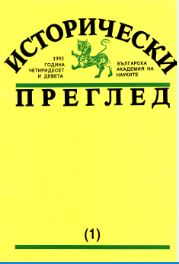Ново тълкуване на търновския златен еднолицев медальон
A New Interpretation of the Tarnovo Gold One-Face Medallion
Author(s): Stamen MichailovSubject(s): History, Archaeology, Cultural history, Political history, Middle Ages, 6th to 12th Centuries
Published by: Институт за исторически изследвания - Българска академия на науките
Summary/Abstract: It has so far been generally accepted that the one-face gold medallion from Veliko Tarnovo should be ascribed to Khan Omourtag and be read as KANE СУВНГI СОМОРТАГ. The iconogfaphy of the Khan, however, is purely that of a Christian ruler with all his attributes of Christian symbolism. It is well known however, that Khan Omourtag was the most violent persecutor of Christians. This contradiction made me question the correct reading of the circular inscription. After the most careful study of the original and appropriate analysis of the letters I arrived at the following conclusions: First, where YBHH was read, I established, on the basis of a comparison with the inscription of another seal of the same type, that in this place it is more correct to read Y(l) ON. Three vertical hatches follow, making the letters П I, and after them follows U). This is the Latin verb pio in a Greek transcription. The last word is MORTA - a hybrid formation of the Greek MOROS and the Latin MORTUUS. The letter hitherto read as gamma (Г) is actually part of the plait of hair falling dawn the left shoulder of the bust. The inscription should, therefore, read as follows: CANES Y(l)ON П10) MORTA. The person depicted could only be a Christian martyr, and this, no doubt, was the heir to the throne Enravotas-Boinos who died a martyr’s death at the hands of his brother Malamir for his fanatical devotion to the Christian faith. Most probably the medallion was fashioned during the reign and the initiative of the pious Prince Boris, at a time when in the country were still the legates of the Papal Court in Rome, headed by Formosus, a fact which also explains the observed hybrid formations in which the Latin language also played an active role.
Journal: Исторически преглед
- Issue Year: 1993
- Issue No: 1
- Page Range: 83-87
- Page Count: 5
- Language: Bulgarian
- Content File-PDF

